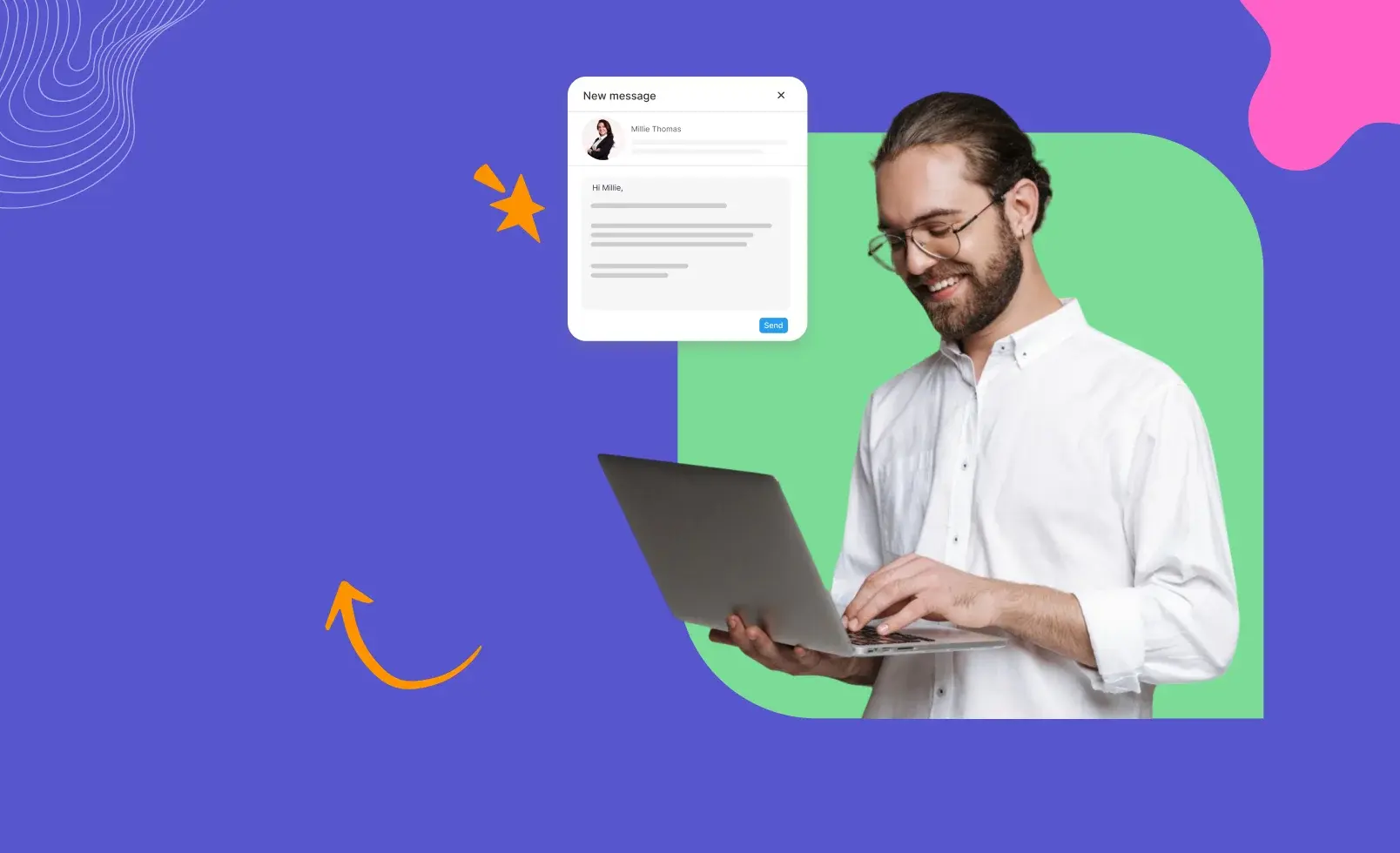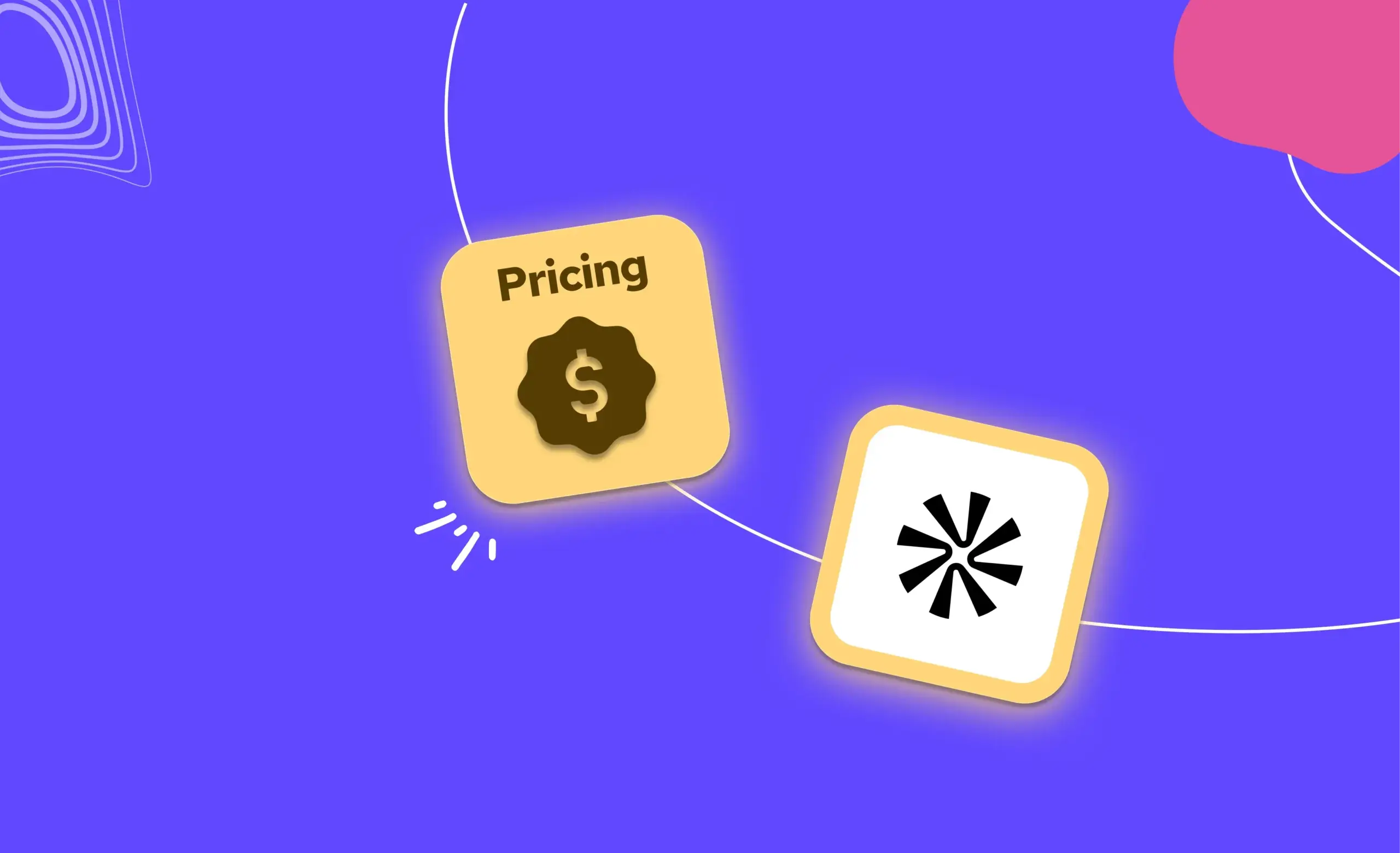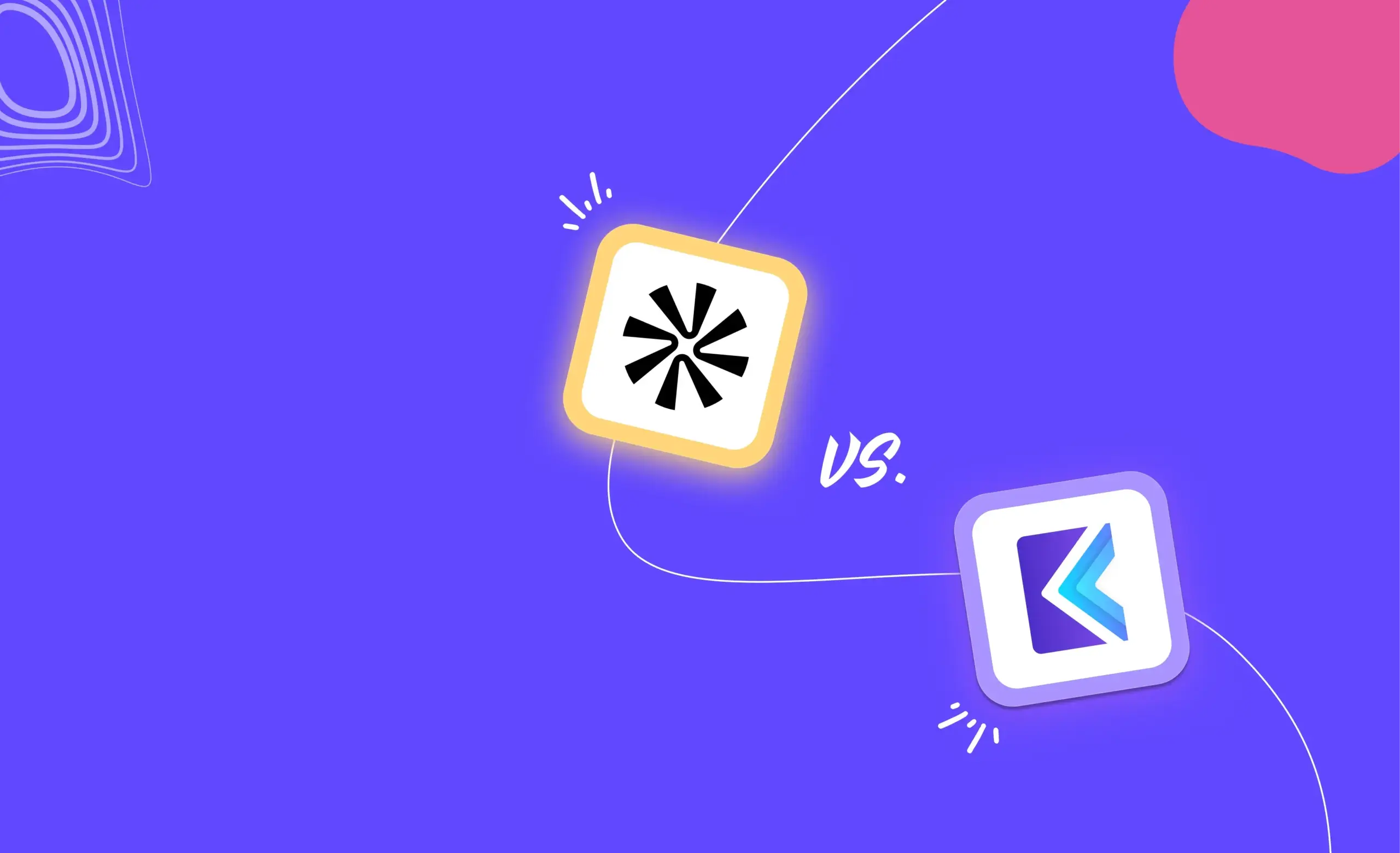Are your LinkedIn campaign messages missing the mark?
According to LinkedIn, InMails to prospects only get a response 10-25% of the time. Despite those odds, InMails are still your best bet when it comes to reaching your prospects on LinkedIn and bolstering your business efforts.
But, with countless professionals vying for attention in your prospects’ inboxes, it’s getting harder to break through the noise and start a conversation with your ideal buyer.
Luckily, we’re here to help!
Whether it’s optimizing your profile, coming up with a killer InMail subject line, or leveraging shared connections, there are plenty of ways to get ahead on LinkedIn.
Read on to learn our top 9 tips for increasing your InMail reply rates on LinkedIn!
What Is LinkedIn InMail?
LinkedIn’s InMail function will change the way you approach cold outreach, letting you send sponsored automatic messages to a targeted audience of your choosing. When your prospects log into LinkedIn, they’ll be greeted with your InMail message at the top of their inbox!
An InMail is just like a regular message on LinkedIn, except you don’t need to be connected to the recipient. Whether you’re contacting them individually or through a sponsored InMail campaign, InMail messages are invaluable when it comes to contacting prospects outside of your network.
How To Send InMails on LinkedIn?
InMails are the perfect way to reach your prospects on LinkedIn, delivering your sales pitch directly to their inbox. There are two ways to send InMails: as a LinkedIn ad campaign or individually through Sales Navigator.
If you’re sending an InMail via Sales Navigator, you can view your individual leads and send targeted DMs through the Sales Navigator platform. Here’s what that looks like at-a-glance:
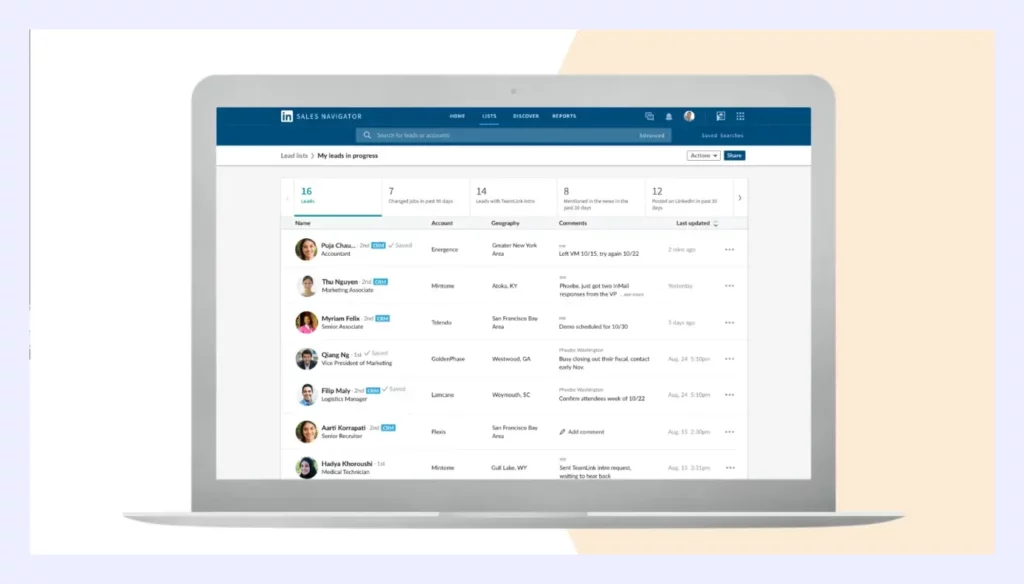
If you want to send message hundreds (and don’t need individual targeting), you can do make in connections in bulk using a LinkedIn ad campaign. When creating your campaign, select either “Conversation” or “Message” as the ad format. This way, when you send your campaign bulk messages out, recipients will receive an InMail from your account with an accompanying personalized message that details your pitch.
Here’s what to select when creating your ad:
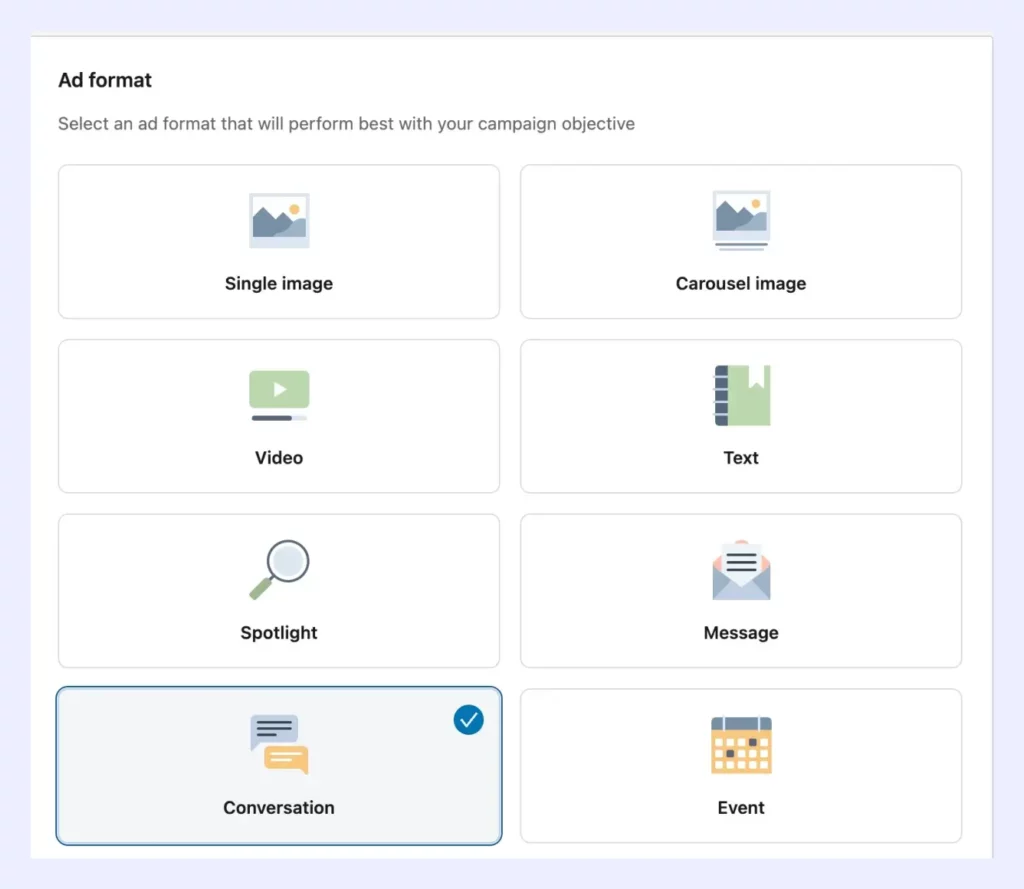
9 Strategies To Boost LinkedIn InMail Response Rates
Now you’re ready to start sending InMail! Well…almost ready. Take a look at our top 9 tips for increasing your InMail open rates.
1. Optimize Your LinkedIn Profile To Create a Lasting First Impression
“Should I trust you?”
That’s what a prospect thinks every time they see a message from someone they don’t know. Whether it’s a recruiter sharing a new role, a 3rd-string connection asking to get coffee, or someone pitching their product, LinkedIn InMail efforts demand a prospect’s time, attention, and trust.
Users are used to interacting with businesses online, with 90% of users using social media for business transactions. So, they’ll see through any tricks! Why should they trust you?
To garner trust, you need to present yourself as a knowledgeable, experienced, high-value individual. From your profile picture to your work experience, everything on your active profile should assure a prospect that their time will be well spent with you, regardless of the outcome.
Nail Your Headline (and Headshot)
When it comes to your profile, you need to nail the first impression. On LinkedIn, that means your headshot (and headline, too).
If you haven’t had a professional photoshoot, no need to stress. A nice picture from a formal event, graduation, or wedding can work in a pinch. If your camera roll lacks solo shots, there are plenty of AI-powered software that can help you generate the perfect headshot for your profile!
Regardless of where you source your profile picture from, just ensure that it’s:
- Professional
- Simple (no busy backgrounds)
- Friendly
- Not a selfie
Here’s a solid example of a great LinkedIn profile picture:

While it’s common practice to have your headline include your job title, skills, or certifications, you’ll get more traction with an action statement.
Here are a couple examples of how to transform your headline:
- If you start with “Marketer @ [Company name]”, a better headline would be “Innovative Marketing Strategist Helping Brands Grow”
- If you’re a Sales Development Representative for [Company name], you could make your headline “Helping Brands Generate Pipeline and Close Deals”
Instead of just stating your job title, include how you (and your product) can help people solve problems. That way, prospects will get an idea of how you can bring them value from the get go.
Keep Your Profile Professional, Approachable, and Informative
If your prospect happens to click to your profile, make sure to keep the charm switch turned on! Your complete profile should:
- Be professional
- Showcase your expertise
- Outline your experience
- Be concise and easy to read
Don’t forget to highlight key accomplishments and skills. If you’re a sales expert, mention specific industries you’ve mastered. You can even include notable sales and marketing achievements to really seal the deal!
Keep the tone friendly, informative, and professional, and you’ll be impressing prospects in no time.
2. Personalize Your InMail Based on Their Profile
Beyond your profile photo and tagline, your connection request messaging is essential for giving that extra nudge. While not all LinkedIn strategies include sending connection requests, if yours does… read on! (if not, skip to strategy #4)
Know Thy Audience
As always, personalization is key to cracking through the noise! To personalize your message to people, know who you’re targeting and research the person you’re talking to.
Basically: show that you’ve done your homework. Mentioning one of their interests, something related to their industry, or referencing something they’ve recently published shows that you’ve taken the time to understand them.
Break Through the Noise by Targeting Pain Points
What does your prospect stand to gain from connecting with you?
Your connection request should answer this, showing your prospect that you’re a meaningful connection.
For example, for a marketing director, you might say something like:
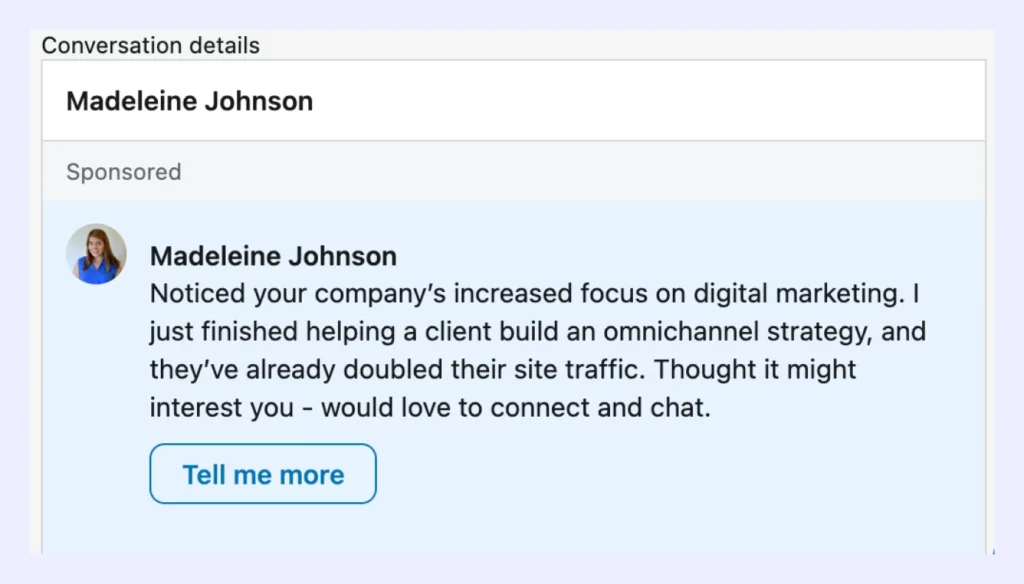
The perfect connection message formula doesn’t exist, but your message should:
- Reference something personal or relevant to their company size/industry
- Relate that thing to what you do
- Tap pain points or offer value
- Include an action item (let’s connect and chat)
3. Leverage Mutual Connections or Interests
Ever end up chatting with someone at a party with whom you have nothing in common?
Yeah, that’s what getting a vague LinkedIn InMail feels like.
To elicit a response from your prospects, you need to tap into shared connections. Whether it’s through a mutual interest, a shared alma mater, or even a mutual friend, there are plenty of ways to connect with your prospects right off the bat.
Establishing Rapport To Build Trust and Credibility
A shared interest, colleague, or other connection makes it easy to establish rapport. A shared peer is obviously the easiest route to connecting with someone. But, when that’s not possible, it’s helpful to establish rapport through other shared interests.
If you went to the same university, you might say something like, “Hey, I saw you graduated from Blah Blah University and studied economics, too (bless us for getting past Sanderson’s 101 class!) I’d love to connect to chat about the new project I saw your company is working on.”
Everyone’s DMs are flooded with messages and connection requests, but a personal touch will help establish trust, signaling to your prospects that you’re worth their time.
Get Specific, Fast
Of course, you don’t need to go through every prospect’s profile with a fine-toothed comb. Often, effective targeting and tailored messaging can do the trick when it comes to personalization!
When you’re sending InMails, creating multiple campaigns with narrower audiences yields better results than creating one message to send en masse. For example, crafting one message for social media managers and another for marketing managers may seem unnecessary. However, the more specific you are, the more your prospects will feel like you really care about their problems and understand their point of view.
As always, mutual connection and understanding between you and your prospects will ultimately help you increase your LinkedIn reply rates and close more deals!
4. Hook Them With a Killer Subject Line
A subject line is a great way to bypass the “Hi John, I’m Mindy” and get right to the point.
Make your subject line the thesis of your message. Instead of saying, “I’d love it if you took a demo,” try using this subject line example, “Want $50?”

Great Subject Line Goes a Long Way
When you send an InMail, your subject line is your first impression. A compelling and attention-grabbing subject line will make your prospect too curious not to click.
Since LinkedIn is typically full of a certain level of niceties and professionalism, being a bit off the cuff can help you stand out from the crowd (a la “Want $50?”)
Provoke Curiosity or Provide Value To Maximize the Impact of Your InMail
What will get your prospect’s wheels turning?
To intrigue your prospect, try posing a question, offering value, or being completely out of the box. For example, you can use a line like, “Beat the tech industry dip” or, “Be a fish 🐟”
5. Send InMails at the Right Time to Maximize Your Open Rate
Like anything in life, a good InMail is all in the timing. If your message arrives in the middle of the night (or end of the workday), it could be buried by the time your recipient wakes up.
Here’s how to time your messages with ease!
Timing Your Messages Increases Open Rates
According to LinkedIn, sending a message when a prospect is online maximizes average response rate. Messaging during business hours is always recommended, but aim for mid-morning or mid-afternoon to catch people right as they’re hitting a slump (but still trying to look productive by going on LinkedIn).
If you’re using sponsored InMails, LinkedIn even has a smart solution that targets prospects by time zone!
6. Use Social Proof in Your InMails
The proof is in the pudding! According to Hubspot, 92% of consumers feel hesitant to buy when there isn’t any proof of others making a purchase.

Social proof makes prospects more confident in their purchase, and in their decision to talk to a sales professional like yourself. Sometimes, it pays to be the path most taken!
How to Use Testimonials and Success Stories in Your Outreach Campaign
Working in a testimonial can sometimes be awkward. But it doesn’t have to be! Try working in a one-liner, like:
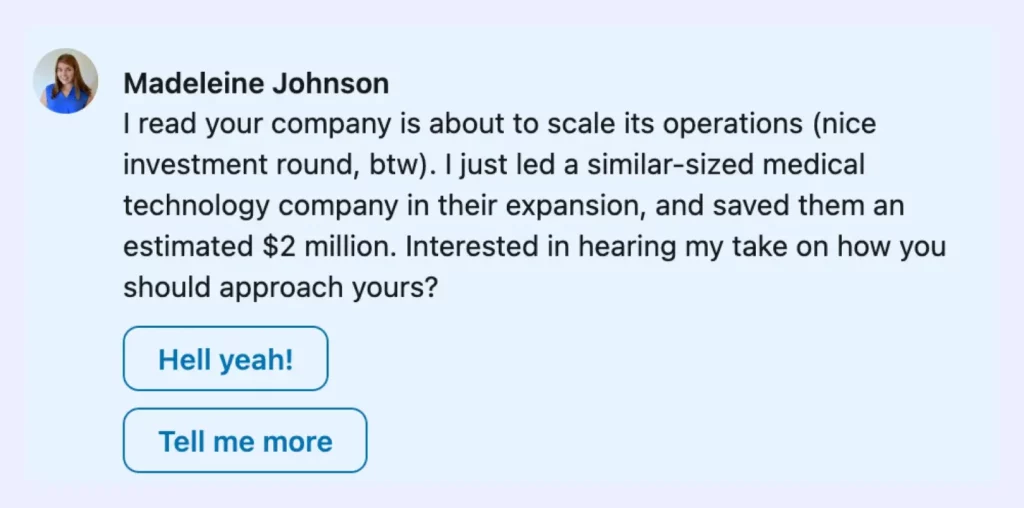
The Impact of Social Proof in Establishing Credibility
Social proof changes the game when it comes to attracting prospects. Based on a Nielsen study, 84% of people say they’d be more likely to buy a software product if a company they knew used the software.
That’s a huge advantage.
Pointing prospects to examples of your success, whether it’s a great G2 rating or ridiculous numbers, will help them feel confident in your ability to help them.
7. Bring Your Prospect Value on a Silver Platter
The key to sealing the deal (or at least garnering interest) is offering a clear value proposition. If a customer is confused, they won’t hesitate to delete your message!
Articulating a clear value proposition helps prospects know exactly what they’re agreeing to.
Tip: after you hone your value proposition and write a killer message, send it to a colleague to hear their take on things. Would they respond to that DM?
Honing Your Value Proposition
Cut the buzzwords out of your message!
Articulating a clear, concise value proposition is essential for any cold outreach strategy. Tell your prospects exactly what they stand to gain from answering your message in clear, concise words.
Most importantly, be explicit about what your prospect stands to gain from interacting with you. For instance:
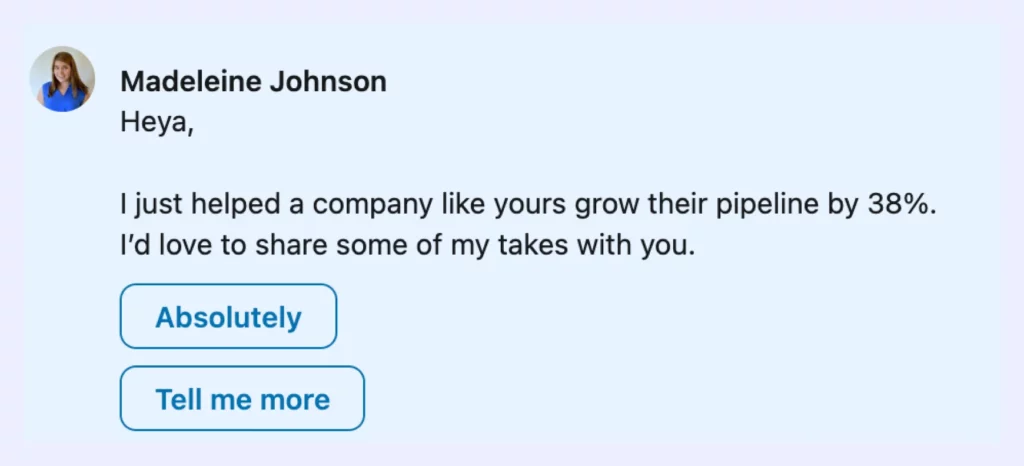
In this case, a prospect who wants more leads (who doesn’t?!) would be eager to take a meeting with you, or at least exchange a few messages to see what you’re all about.
How To Align Your Offer With Your Prospect’s Pain Points
Know thy prospect!
More importantly, know their pain.
By linking your value proposition directly to your prospect’s challenges, you’ll make your offer irresistible.
For example, you could say, “I see you have a bunch of job openings - are you expanding? I just helped a company like yours scale their operations by 40%. I’d love to share some of my insights with you to help smooth your transition.”
8. Leverage LinkedIn’s Advanced Features
Manual outreach is a slog, no matter who you are. LinkedIn’s advanced features are a godsend for leveling up your prospecting power.
Have you tried them yet?
InMail and Sales Navigator Are Your New Best Friends
If you want to level up your LinkedIn outreach (and increase your positive reply rates), InMail and Sales Navigator are essential.
Sales Navigator is perfect for targeted prospecting and relationship building, helping you search and find the ideal prospects (and helping you increase reply rates on LinkedIn). With lead and account recommendations, real-time insights, and integration with your CRM, it helps you keep tabs on all your leads.
InMail is the key to personalized, direct contact. Instead of sending connection requests into the void, an InMail lets you cut to the chase, giving you direct access to your prospects’ DMs. It lets you personalize messages at scale, letting you keep your unique touch while sending communication en masse.
How To Maximize Reach With Sales Navigator
With advanced targeting and direct contact, you can zip straight to your prospects’ inboxes. Here are a few tips to getting the most bang for your buck:
- Sales Navigator’s advanced search filters help you identify your dream prospects. The more refined your search, the more likely you are to boost your reply rates!
- Integrating with your CRMs streamlines the whole process, giving you a cohesive and updated view of your prospects.
- Helpful insights tell you your prospects’ activities on LinkedIn. From viewing and engaging with their posts to seeing what they “like”, get the 411 on what they’re interested in before you take the plunge and send that message!
- Save and monitor leads in Sales Navigator for future use. You can check for updates like job changes and company news - both perfect times to contact a prospect and generate business opportunities!
9. Mind Your (LinkedIn) Manners
When sending a casual message, you can be fun - but keep things professional. Remember: this person doesn’t know you. So, keep in mind:
- Don’t be too “salesy.” This is about making a connection and providing value - not hitting your quota.
- Skip the templates. We’ve all gotten sales messages, and we’re all tired of hearing the same spiel.
- Don’t be too pushy. AKA, don’t follow up too frequently, or demand a response. Be respectful!
- Leave the buzzwords at the door. We’re tired of them.
As you see what works (and what your prospects respond to), you can tailor your message for an effective approach and push the boundaries on LinkedIn. But remember: keep it polite!

Now You Know How To Increase LinkedIn InMail Response Rate!
Ready to boost your LinkedIn reply rate? We sure hope so!
LinkedIn is the perfect platform for connecting with prospects. While it’s a bit saturated with people using similar strategies, delivering value and standing out from the crowd should help you get noticed (and increase your replies).
Remember to:
- Create a great profile
- Personalize your connection requests
- Leverage mutual interests and connections
- Tailor your message content
- Write a killer subject line
- Time your messages right
- Use social proof
- Deliver value
- Leverage Sales Navigator and InMail
- Mind your manners
With these in mind, you’re ready to kill it.
Happy messaging!
About the author:
Madeleine Johnson is the Content & Community Manager @ Synup. She takes pride in doing everything from building killer content and executing product marketing strategies to interacting with clients and generally helping Synup run smoothly. You can find her on LinkedIn here!
